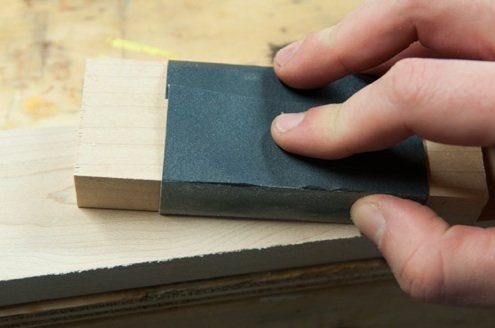How To Use A Sanding Block

Photo: Chris Gardner
Sanding is the unsung hero of any project with wood. It can take a long time, and the results are subtle: Sanding does not transform your workpiece in the way that cutting it to size does. Nor does sanding deliver the "wow factor" of a rich stain. But make no mistake, it is the key step to be taken when turning raw wood into an investment piece, one that adds value to your home or lifestyle.
What Is Sanding?
Though sanding makes wood feel smoother, it's really the process of abrading wood fibers so that they are rendered uniformly rough. We call it "sanding"—and the tools employed are sandpaper and sanders—but no sand whatsoever is involved. Rather, the abrasive performs as a cutting tool (not unlike a saw blade), which can be used to cut, shape, and finish raw wood either to completion or to the point where the material readily accepts a finish.
Sanding by Hand
Hand-sanding gives you the most control over shaping the wood surface. You can address corners and recesses that a machine would not be able to reach. Yes, I use powered sanders on nearly every woodworking or finishing project I complete, but I always do some sanding by hand.
Related: 5 Easy Woodworking Projects for Beginners

Photo: Chris Gardner
For flat surfaces and sharp edges, use a sanding block; buy one at the hardware store or cut your own from scrap wood. The sanding block enables you to apply even pressure, and it prevents your sandpaper from bunching up or slipping. If you're sanding molding or trim with an intricate silhouette, opt for a specialty rubber or foam profile sander in order to pull off a sharp, professional look.
When sanding curves or forming a rounded edge, forgo the sanding block and use the softness of your hands to create a satisfying arc shape.
No matter what type of edge you're going for, always maintain steady pressure and sand with, not against, the grain. Don't employ sandpaper to remove things like pencil marks or dried glue, but do use it to smooth joints or filled nail holes.

Photo: Chris Gardner
It's not strictly necessary for any job, but a powered sander can sure save you a lot of time and sweat. I highly recommend the random-orbit sander, if you don't already own one. The perfect tool for so many tasks, it smoothes wood quickly and evenly, and it does so without leaving surface marks. Sanding disks of varying grits may be affixed, and especially when the tool is connected to a shop vac, sawdust is not an issue.

Photo: Chris Gardner
Sanding for Finishing
Sanding helps not only prior to finishing, but also during finishing. If you plan to stain or clear-coat your workpiece, first sand with 220-grit paper, then wipe down the surface with a wet rag or sponge. This raises the grain, making the wood more receptive to stain. Applying an oil finish? Sand the surface to 220, then apply Danish or teak oil (with the grain) using 320-grit paper. Continue until you get a light "slurry" of sawdust and oil.

Photo: Chris Gardner
Last but not least: If you intend to paint your workpiece, then sanding will be essential to your success. It "roughs up" the surface, giving the paint something to stick to. Plus, sanding between coats of paint smoothes out any bumps or raised areas that are produced, so you are left with a super smooth, factory-like finish.
How To Use A Sanding Block
Source: https://www.bobvila.com/articles/sanding-wood/
Posted by: turnerprouncer.blogspot.com

0 Response to "How To Use A Sanding Block"
Post a Comment